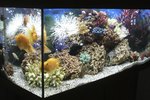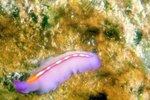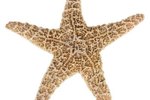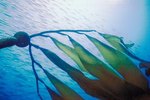Food chains and food webs are charts that explain the layers of organisms within an ecosystem and which organism eats the others. These layers are labeled with names such as "primary producers" and "secondary producers." Algae is a simple form of life that often appears in the lowest levels of a food chain because it is consumed by different animals.
Algae
Algae are simple organisms that can be either single- or multi-celled organisms. Algae does not consume organic materials; instead, it feeds on the waste materials produced by decomposing materials and the waste of marine animals. The growth of algae is dependent on the process of photosynthesis where the bacteria that forms the organisms takes energy from the rays of the sun to use for growth. Algae only grows in oceans, lakes and other waterways at the depth of the photic layer, where the rays of the sun penetrate the water.
Primary
As a primary producer of food for other organisms and animals, algae is a food source for animals known as primary consumers. The animals seen as primary consumers include zooplankton, which is made up of the small larvae of larger fish that grow to become consumers at different levels of the food chain. Other animals also known as zooplankton are small animals, such as adult worms and crustaceans that spend their lives feeding on algae.
Secondary
Secondary consumers on the next level of the food chain also consume algae along with other forms of marine plants and animals. Secondary consumers include the baleen whale and the much smaller herring. The baleen whale is a large mammal with few predators that filter materials from the ocean through their mouths, this material includes algae and plankton. Herring is a smaller fish that also consumes algae to provide food for survival.
Green Algae
Green algae often forms in blooms on the surface of waters, such as lakes and ponds with green algae forming the most common type of algae. Chlorophyta is a form of green algae that grows in water that includes some of the most plant-like forms of green algae, such as sea lettuce. Blooms of green algae cause problems because they can spread over large areas of wet soil and damp media. Algae can also cause problems to irrigation systems that can become clogged and overrun by algal blooms.
References
Photo Credits
-
Hemera Technologies/Photos.com/Getty Images
Writer Bio
Paul Cartmell began his career as a writer for documentaries and fictional films in the United Kingdom in the mid-1990s. Working in documentary journalism, Cartmell wrote about a wide variety of subjects including racism in professional sports. Cartmell attended the University of Lincoln and London Metropolitan University, gaining degrees in journalism and film studies.





